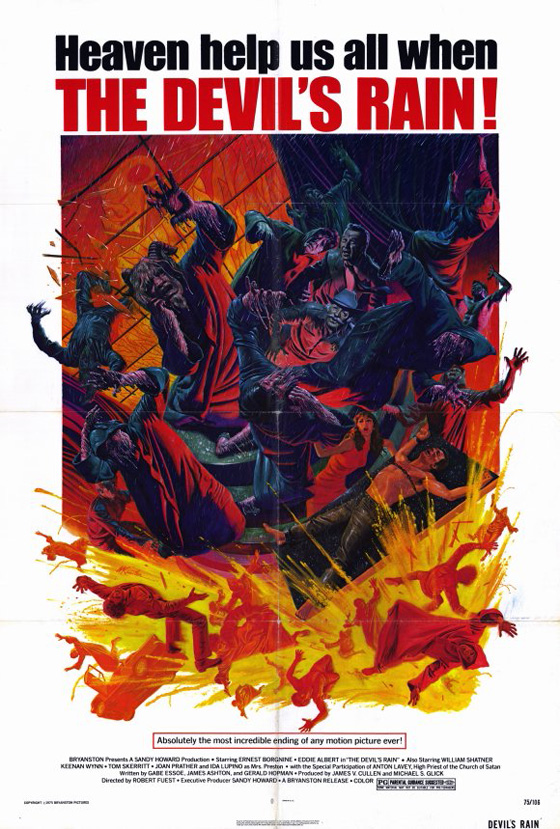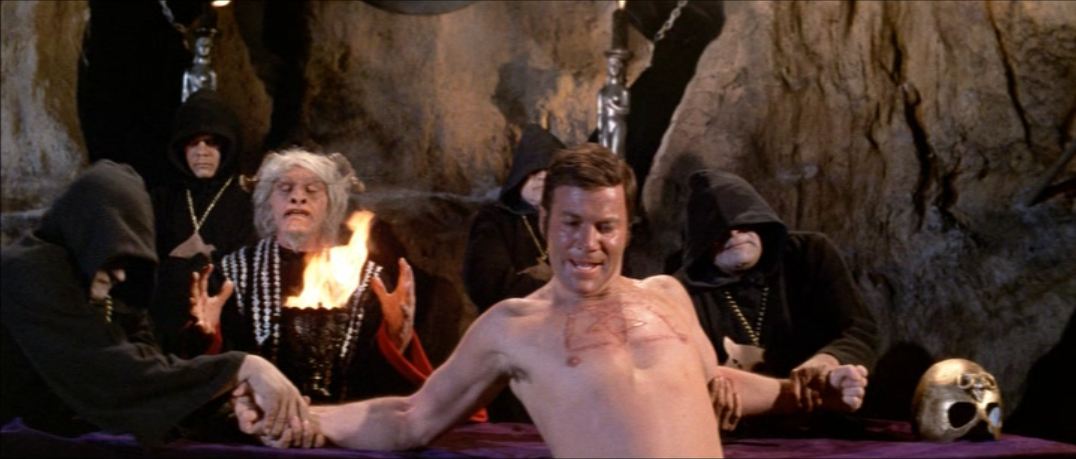
If cinema is to be believed, there was a period from about 1968 (and Rosemary’s Baby) through 1981 (and Omen III: The Final Conflict) in which Satan’s minions rose in throngs throughout the world, and we were ever on the brink of the Biblical Apocalypse. Babies were born with 666 scrawled on the scalp. Cultists dressed like Tolkien’s Ringwraiths lumbered about with torches and chanted in gobbledygook Latin over naked women chained to stone altars. Invisible devils hopped from one innocent body to another, and green vomit spattered the walls. Satanic horror took full advantage of the no-limits realm of 1970’s genre cinema, in the grindhouse and the mainstream drive-ins alike: for every Exorcist (1973) there were dozens of Exorcisms (1974) or Abbys (1974). Even television got a Look What’s Happened to Rosemary’s Baby (1976). So in the midst of all this madness, when the very earth was about to tear itself asunder by the mighty forces of black magic, it was strangely inevitable that the likes of William Shatner, Ernest Borgnine, Tom Skerritt, Eddie Albert, Ida Lupino, and John Travolta would travel to the American West for a good-and-evil battle in The Devil’s Rain (1975).
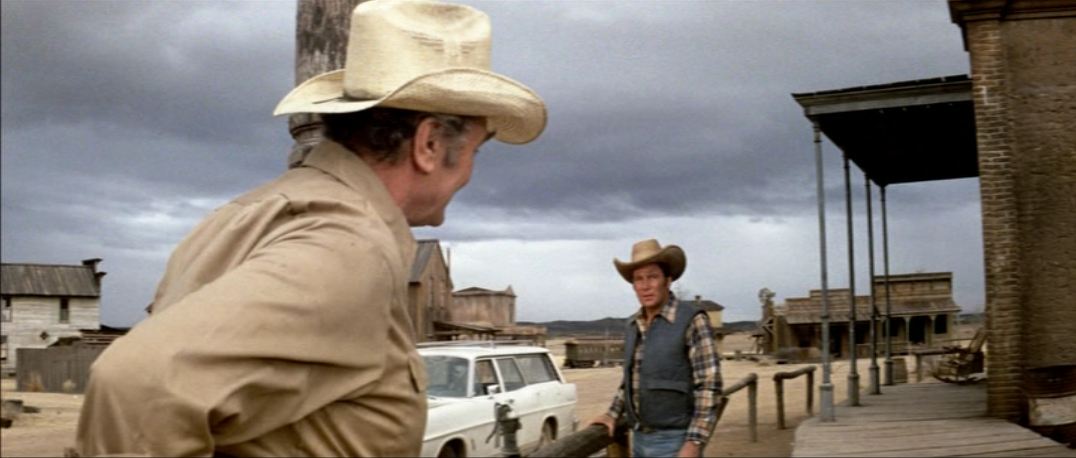
Cult leader Corbis (Ernest Borgnine) is confronted by the avenging Mark Preston (William Shatner) in a Satanic ghost town.
What makes this particular Satanic outing so intriguing is not the behind-the-scenes input of Satanic Bible author Anton Szandor LaVey – the film doesn’t seem to come within a country mile of anything “authentic” – but rather its delirious genre mash-up of a plot, for it’s quite obvious that The Devil’s Rain is actually a Western from the moment that Shatner and Borgnine square off on the dusty street of a ghost town wearing cowboy hats. (Never mind that Shatner’s cowboy hat appears to be made of wicker and would offer neither shade from the sun nor shelter from the rain, devil’s or otherwise.) That this moment happens so soon in the film is an indication that it has no time to waste – we are thrust into the middle of a plot we can scarcely grasp: first Mark Preston (Shatner) arrives home to find his father’s eyeless face melting off in a gooey mess, Lost Ark-style, as he comes stumbling out of the rain. He knows at once what is happening: the Satanist Jonathan Corbis (Borgnine) wants the return of a mysterious book that Preston and his mother (Lupino, a Hollywood legend) keep hidden away beneath the floorboards of their house. He travels to a deserted mining town called Red Stone with a magical amulet around his neck for protection, but when he meets up with Corbis in an old church used by the devil-worshipers, he discovers that his mother has now been corrupted – her eyes are now just black sockets – and he is quickly overcome by the chanting, black-cloaked cultists (one of whom is a pre-Kotter John Travolta).
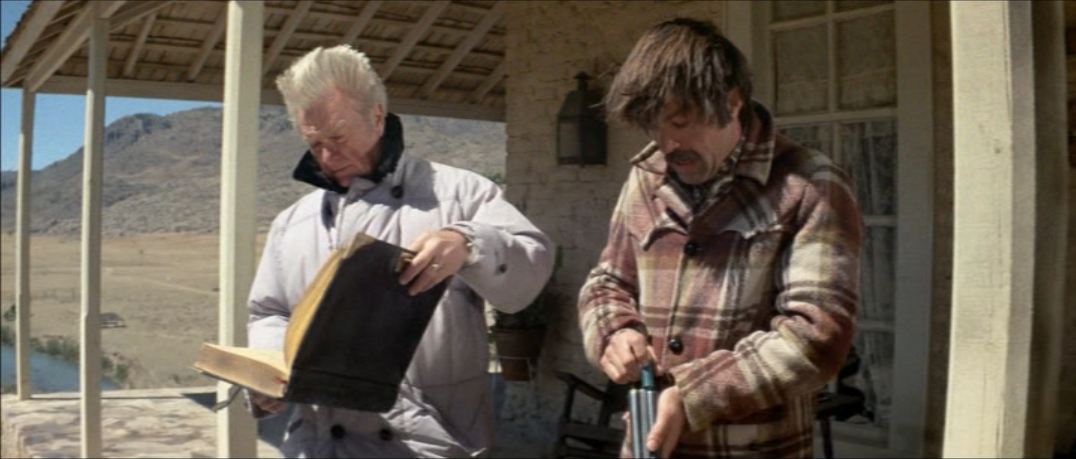
Eddie Albert helps Tom Skerritt battle the forces of evil.
With Act One abruptly ended, the plot turns to Mark’s brother, Dr. Tom Preston (Tom Skerritt of Alien), a research scientist who begins the investigation of his family’s disappearance by first talking to the crusty sheriff (ubiquitous character actor Keenan Wynn), and then teaming up with Dr. Richards (Eddie Albert of Green Acres) to discover that his family’s prized book is actually a list of the names of disciples of Corbis’s centuries-old church, all written in blood and beside some pretty nifty illustrations of devils and the damned. Tom and his telepathic wife Julie (Joan Prather, who appeared with both Skerritt and Shatner in Big Bad Mama) head out to Red Stone where things fall apart fast: Satanists chase them through the wilderness, eyeless Travolta tries to kill them, Corbis transforms into a goat-man, and Richards discovers a large jar with a window (or television monitor) that gives a view to the tormented and rain-soppy souls of Corbis’s victims. The final ten minutes or so are given to face-melting and screaming, as the cultists disintegrate into puddles of green and yellow goo; this is followed by a “twist” ending that’s pretty typical of the genre.
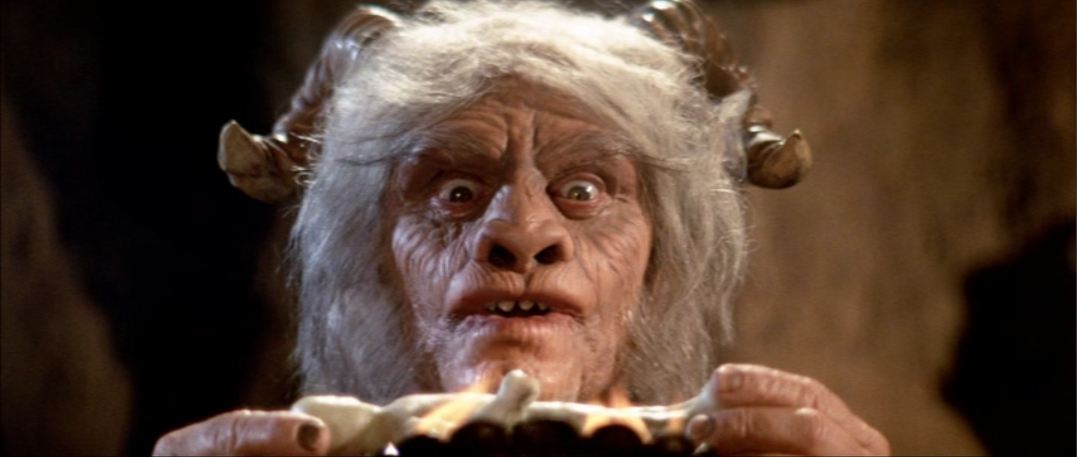
Goat-man Borgnine wields a voodoo doll as he torments Shatner.
To call the film silly or hokey is beside the point; it is exactly what you need it to be, with each iconic actor amusingly indulging in their particular acting tics: Shatner pausing in his dialogue delivery; Borgnine gloating with Wild Bunch smarm; and Skerritt, in my favorite moment, expressing his frustration by fussing with his prop-glass, making a peculiar and meaningless unscrewing motion near its base, then smashing it against the desert rocks in impotent fury. But although the camp qualities are obvious, The Devil’s Rain is a cut above most of the Satanic-themed B-movies of the 70’s for a few reasons. One is the quality of the FX- there’s a reason the film decides to waste so much time on face-melting, which is that it’s pretty well done. Particularly impressive is Borgnine’s goat-man makeup, although it’s of such a high caliber, and so well-lit, that it perversely takes the film out of the realm of supernatural horror and into fantasy, even SF – Borgnine’s appearance in horns and flaring nostrils reminds one of a Planet of the Apes film or a particularly strange episode of Star Trek (fueled by Shatner’s presence). The second key element that makes The Devil’s Rain so notable is its British director, Robert Fuest, who had already made a significant mark on 70’s genre cinema with the Polanski-esque And Soon the Darkness (1970), the tongue-in-cheek Vincent Price vehicles The Abominable Dr. Phibes (1971) and Dr. Phibes Rises Again (1972), and the Michael Moorcock adaptation The Final Programme (1973). Fuest, who passed away last year, could always be counted on to deliver plenty of style with a small budget, and The Devil’s Rain is no exception, even if that style is applied to such absurd elements as Borgnine’s jar of the damned or psychic premonitions or Shatner engaging in fisticuffs with Satanists in the dusty streets of Red Stone. Recommended consumption for a Saturday night: pair this with Race with the Devil (1975), from the same year, and throw in some era-appropriate horror trailers in-between.
Rated PG for lots of green goo and magic amulets suddenly turning into snakes.
